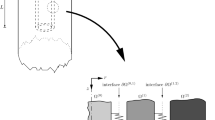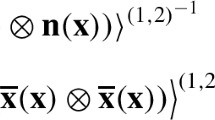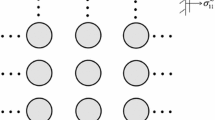Abstract
Estimates are proposed for the linearly elastic properties of dilute composites reinforced by either spherical particles or circular fibers that are imperfectly bonded to the surrounding matrix. This imperfection is represented via interfacial bonding conditions requiring continuity of tractions but permiting discontinuities of displacements that are proportional to the tractions. Elastic anisotropy of the matrix and the reinforcements can be arbitrary, but that of the interfacial bond is restricted to a particular form of common use. Like the variational estimates of Gallican et al. (J Elast 153:373–398, 2023), the new estimates incorporate a dependence on bonding compliance through an equivalent stiffness tensor for the reinforcing phase. But instead of depending on either the arithmetic or harmonic mean of the bonding compliance, the equivalent stiffness tensor is made to depend on a function of the degree of bonding compliance anisotropy chosen in such a way that certain conditions for the elastic neutrality of rigid reinforcements are recovered exactly. The resulting estimates can be cast in variational form and interpreted as an interpolation between estimates of the arithmetic and harmonic type. Explicit expressions for effective shear moduli of isotropic composites are provided and confronted to exact results for assessment. Predictions are asymptotically exact when bonding compliance is weakly anisotropic, and are found to improve on earlier predictions of the arithmetic and harmonic type when bonding compliance is moderately anisotropic.



Similar content being viewed by others
References
Hashin Z (1990) Thermoelastic properties of fiber composites with imperfect interface. Mech Mater 8:333–348
Nazarenko N, Stolarski H (2016) Energy-based definition of equivalent inhomogeneity for various interphase models and analysis of effective properties of particulate composites. Compos B 94:82–94
Zecevic M, Bennett KC, Luscher DJ, Lebensohn RA (2021) New self-consistent homogenization for thermo-elastic polycrystals with imperfect interfaces. Mech Mater 155:103651
Gallican V, Zecevic M, Lebensohn RA, Idiart MI (2023) The elastic properties of dilute solid suspensions with imperfect interfacial bonding: variational approximations versus full-field simulations. J Elast 153:373–398
Qu J (1993) The effect of slightly weakened interfaces on the overall elastic properties of composite materiales. Mech Mater 14:269–281
Lee HK, Pyo SH (2007) Micromechanics-based elastic damage modeling of particulate composites with weakened interfaces. Int J Solids Struct 44:8390–8406
Yanase K, Ju JW (2012) Effective elastic moduli of spherical particle reinforced composites containing imperfect interfaces. Int J Damage Mech 21:97–127
Dinzart F, Sabar H (2017) New micromechanical modeling of the elastic behavior of composite materials with ellipsoidal reinforcements and imperfect interfaces. Int J Solids Struct 108:254–262
Lipton R, Vernescu B (1995) Variational methods, size effects and extremal microgeometries for elastic composites with imperfect interface. Math Models Meth Appl Sci 5:1139–1173
Bigoni D, Serkov SK, Valentini M, Movchan AB (1998) Asymptotic models of dilute composites with imperfectly bonded inclusions. Int J Solids Struct 35:3239–3258
Gallican V, Zecevic M, Lebensohn RA, Idiart MI (2023) The elastic properties of dilute solid suspensions of imperfectly bonded ellipsoids: variational approximations versus full-field simulations. In preparation.
Willis JR (1982) Elasticity theory of composites. In: Hopkins HG, Sewell MJ (eds) Mechanics of solids, the Rodney hill 60th anniversary volume. Pergamon Press, Oxford, pp 653–686
Hashin Z (1991) Thermoelastic properties of particulate composites with imperfect interface. J Mech Phys Solids 39:745–762
Thorpe MF, Jasiuk I (1992) New results in the theory of elasticity for two-dimensional composites. Proc R Soc Lond Ser A Math Phys Sci 438:531–544
Acknowledgements
This work was supported by the Air Force Office of Scientific Research (U.S.A.) under award number FA9550-19-1-0377 and by the Universidad Nacional de La Plata (Argentina) through Grant I-2019-247.
Author information
Authors and Affiliations
Corresponding author
Ethics declarations
Conflict of interest
The authors declare that they have no conflict of interest.
Additional information
Publisher's Note
Springer Nature remains neutral with regard to jurisdictional claims in published maps and institutional affiliations.
Appendices
Appendix 1: A procedure to determine elastic moduli of isotropic composites
Making use of the overall balance of average strains over each phase and of the divergence theorem within the inclusions, the free-energy density of a suspension can be written as
where \(\overline{\varvec{\varepsilon }}\) is the macroscopic strain tensor, \(\widetilde{\mathbb {C}}\) is the effective stiffness tensor, \(\textbf{u}\) is the displacement field, the superscripts (1) and (2) refer to the limiting values at the interface evaluated from the matrix side and from the particle side, respectively, and \(\ell\) is the volume to surface ratio of inclusions. The effective elastic moduli of the suspension can then be determined from knowledge of these displacement fields for particular macroscopic deformations. In the case of isotropic suspensions of spherical particles, the effective stiffness tensor is isotropic and fully characterized by the effective bulk \(\widetilde{\kappa }\) and shear \(\widetilde{\mu }\) moduli. The effective bulk modulus has been given by Hashin [13]. The effective shear modulus can be determined by considering axisymmetric strains of the form \(\overline{\varvec{\varepsilon }}= \overline{\varepsilon }(3 \textbf{e}\otimes \textbf{e} - \textbf{I})\) and solving for the local mechanical fields. The components of the stress and displacement fields in a spherical coordinate system centered at the particle admit a separated solution of functions of the radial coordinate multiplied by Legendre polynomials as in expressions (37) of [13]. Once computed, expression (12) for the effective shear moduli is obtained by introducing the displacement fields in (28) and performing the required integrations over the interface.
Appendix 2: A variational format for the new estimates
The effective mechanical response of a dilute composite can be written as
where \(\overline{\varvec{\varepsilon }}\) and \(\overline{\varvec{\sigma }}\) are the macroscopic strain and stress tensors, and \(\widetilde{w}\) is the homogenized or effective free-energy density of the composite given by [4]
Here, \(w^{(r)}\) and \(\textrm{w}^{(1,2)}\) are the free-energy densities of each constituent phase and of the bonding, respectively, \(c^{(r)}\) and \(\langle \cdot \rangle ^{(r)}\) refer to the volume fraction of phase r and the volume average over the subdomain \(\Omega ^{(r)}\) occupied by that phase, respectively, \(\mathchoice{\text{ K }}{\text{ K }}{\text{ K }}{\text{ K }}(\overline{\varvec{\varepsilon }},\textbf{d})\) is the set of kinematically compatible strain fields of the form \(\varvec{\varepsilon }(\textbf{x}) = \overline{\varvec{\varepsilon }}+ \nabla \otimes _s\textbf{v}(\textbf{x})\) with \(\textbf{v}:\Omega \rightarrow \mathbb {R}^3\) square-integrable with compact support and such that its gradient is also square-integrable in each subdomain \(\Omega ^{(r)}\) and the interfacial jump is \(\llbracket \textbf{v}(\textbf{x}) \rrbracket = \textbf{d}(\textbf{x})\) on the surface \(\Gamma ^{(1,2)}\) occupied by the bonding.
Making use of the Legendre transform, we decompose the free-energy density of linearly elastic bondings as
where \(\beta \in [0,1]\) is a dimensionless parameter to be chosen. Introducing this decomposition into (30) we obtain the alternative representation
A variational approximation for composites reinforced by spherical particles or circular fibers can now be derived by considering the trial fields
so that
where \(\mathbb {R}^{(1,2)}_H\) and \(\mathbb {R}^{(1,2)}_A\) are the harmonic and arithmetic mean tensors, respectively, as given by expressions (4), and
It is shown in [4] that when the constituent phases are linearly elastic and the free-energy densities \(w^{(r)}\) are thus quadratic functions of strain, the minimizing strain in the approximation (33) is uniform within the reinforcements, and the resulting approximation for the effective stiffness tensor is of the form (1) with the equivalent stiffness tensor for the reinforcing phase given by (3) but with the interfacial tensor \(\mathbb {R}^{(1,2)}\) given by the modified tensor (34). Thus, a variational estimate for the effective stiffness tensor has been generated, for any choice of parameter \(\beta\). The extreme choices \(\beta =0\) and \(\beta =1\) generate the variational estimates of the harmonic and arithmetic type derived by [4]. On the other hand, the choice
generates the modified estimates proposed in this work, given that the interfacial stiffness tensor (34) agrees exactly with the modified stiffness tensor (8) in this case.
Rights and permissions
Springer Nature or its licensor (e.g. a society or other partner) holds exclusive rights to this article under a publishing agreement with the author(s) or other rightsholder(s); author self-archiving of the accepted manuscript version of this article is solely governed by the terms of such publishing agreement and applicable law.
About this article
Cite this article
Gallican, V., Idiart, M.I. Improved estimates for the elastic properties of dilute composites with imperfect interfacial bondings of moderate anisotropy. Meccanica 58, 1799–1808 (2023). https://doi.org/10.1007/s11012-023-01699-6
Received:
Accepted:
Published:
Issue Date:
DOI: https://doi.org/10.1007/s11012-023-01699-6




